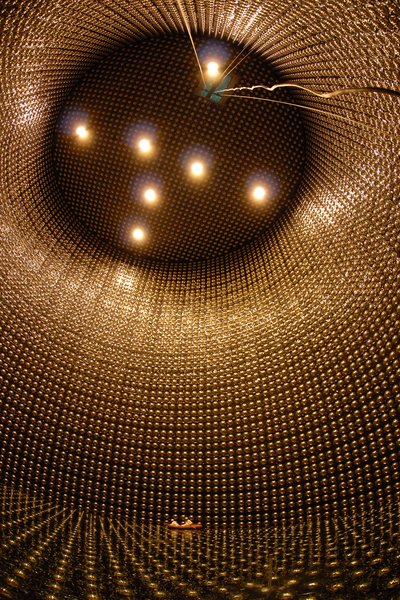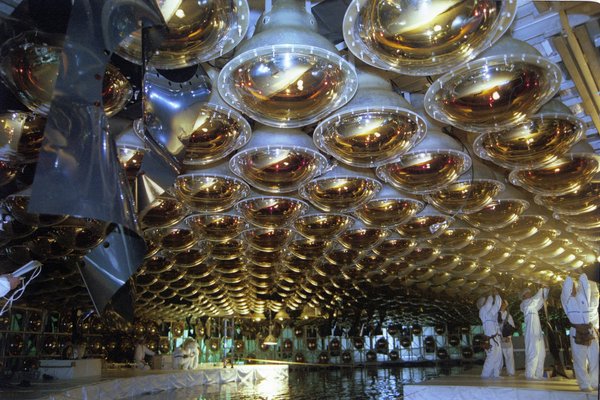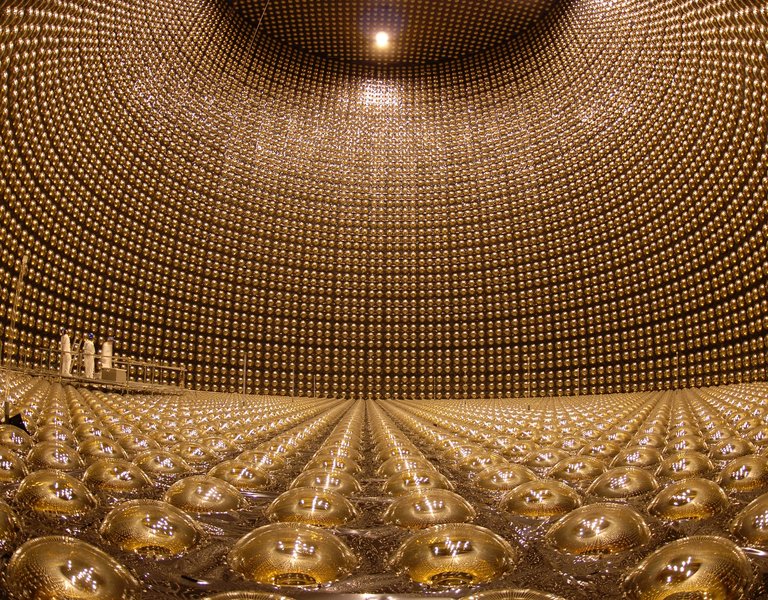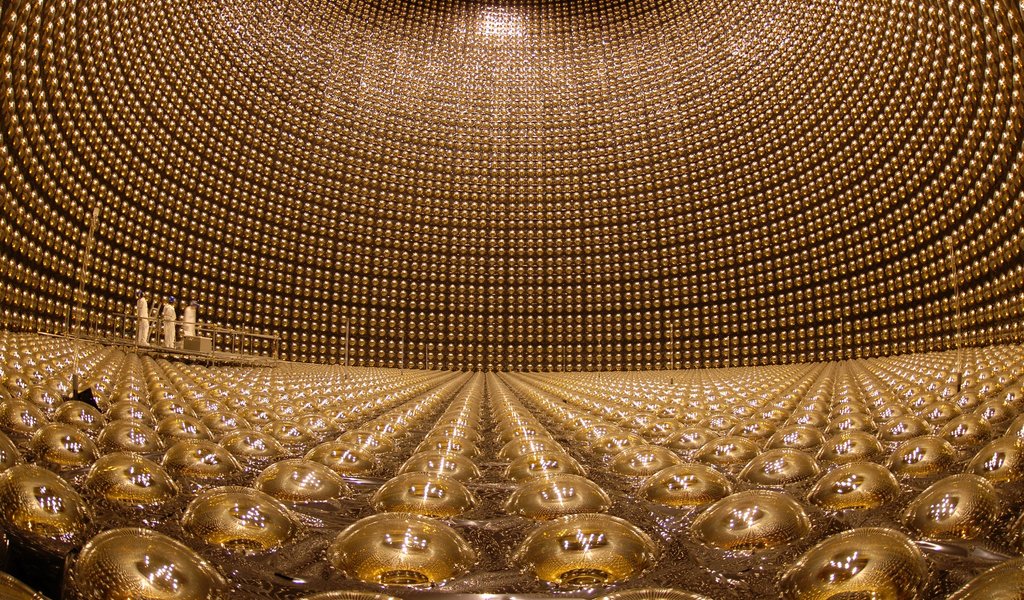Polish research contributes to discovery awarded with Nobel Prize
The Nobel Prize in Physics announced in October this year was awarded to a complex research project contributed to by Prof. Danuta Kiełczewska of the Institute of Experimental Physics at the University of Warsaw. Her PhD students continue to participate in experiments that are a continuation of these studies.
The Nobel Prize in Physics announced in October this year was awarded to a complex research project contributed to by Prof. Danuta Kiełczewska of the Institute of Experimental Physics at the University of Warsaw. Her PhD students continue to participate in experiments that are a continuation of these studies.
This year's Nobel Prize in Physics was awarded for a discovery related to neutrinos – one of the most mysterious elementary particles. They have no electrical charge and interact poorly with matter, leading physicists to think, until recently, that they have no mass. The Nobel Prize-winning discovery showed that not only do neutrinos have mass, they are also able to change identities. Two scientists were awarded for this discovery: Takaaki Kajita, working at the Super-Kamiokande neutrino detector in Japan, and Arthur B. McDonald of the Sudbury Neutrino Observatory in Canada.

“The fact is, that this achievement was possible thanks to approximately 200 people from research teams that conducted the research in Japan and Canada,” Dr. Piotr Mijakowski of the National Center for Nuclear Research told Polska.pl. – Prof. Danuta Kiełczewska of the Institute of Experimental Physics at the University of Warsaw was one of the key contributors to the research carried out at the Super-Kamiokande detector in Japan, involved in the project since its inception. She conducted her experiments under the supervision of Takaaki Kajita, one of the two Nobel laureates, and contributed to the discovery awarded with this year's Nobel Prize. As a result, Poland’s contribution to this year’s Nobel Prize in Physics should not be overlooked.
Prof. Kiełczewska participated in the discovery of neutrino oscillation (i.e. the change of neutrino flavours which took place in 1998 at the Japanese detector. Due to this discovery researchers found out that these particles have mass. The Polish scientist also participated in experiments focusing on proton decay and analysis of the properties of atmospheric and solar neutrinos.
Polish researchers continue to be involved in research on neutrino properties. In recent years, experiments at the Super-Kamiokande detector in Japan have been carried by Prof. Kiełczewska's former students at the Warsaw Neutrino Group, which brings together researchers from the National Center for Nuclear Research and the Faculty of Physics at the University of Warsaw. Polish physicists analyse the data collected at the neutrino detector and conduct computer simulations, working on a remote basis with other participants in the experiment. They also go to Japan to be on duty in person at the Super-Kamiokande neutrino detector. It is a very unusual building: a cylinder carved in solid rock, located in a former mine 1 km beneath the earth's surface. The tank is filled with crystal clear water on which thousands of “electronic eyes, i.e. sensors installed on the walls, are focused. Their task is to detect neutrino interactions with the water.
“Working at the Super-Kamiokande neutrino detector together with colleagues from different countries, I explore the phenomenon of neutrino oscillation, i.e. the change of flavours of these particles, as physicists call it,” says Dr. Mijakowski of the National Center for Nuclear Research. "There is still much to discover in this area, not only in terms of precise measurements of the neutrino properties, but also in terms of explaining the details of the way the universe is built, as there are still many things we do not know in this regard."
 “At Super-Kamiokande, we also try to solve the mystery of the asymmetry of matter and antimatter in the visible universe, since as far as we know, there is too little of the latter,” says Dr. Magdalena Posiadała-Zezula of the Faculty of Physics at the University of Warsaw and a member of the Warsaw Neutrino Group. She also added that a group of Polish researchers is involved in an experiment related to antimatter, including antineutrinos.
“At Super-Kamiokande, we also try to solve the mystery of the asymmetry of matter and antimatter in the visible universe, since as far as we know, there is too little of the latter,” says Dr. Magdalena Posiadała-Zezula of the Faculty of Physics at the University of Warsaw and a member of the Warsaw Neutrino Group. She also added that a group of Polish researchers is involved in an experiment related to antimatter, including antineutrinos.
According to researchers, expanded knowledge on neutrinos may explain many issues which are still troubling physicists. These relate to the way the universe is built and whether our theories in this field are correct. Do we understand how the sun works, what particles from its interior reach us and what impact they have on us?
Perhaps one day we will manage to make neutrinos serve humanity, and a completely new field of knowledge will emerge, just like in the case of the discovery of electrons followed by the emergence of electronics. Research carried out by Polish scientists can be a significant contribution in this noble effort.
ALEKSANDRA STANISŁAWSKA
This year's Nobel Prize in Physics was awarded for a discovery related to neutrinos – one of the most mysterious elementary particles. They have no electrical charge and interact poorly with matter, leading physicists to think, until recently, that they have no mass. The Nobel Prize-winning discovery showed that not only do neutrinos have mass, they are also able to change identities. Two scientists were awarded for this discovery: Takaaki Kajita, working at the Super-Kamiokande neutrino detector in Japan, and Arthur B. McDonald of the Sudbury Neutrino Observatory in Canada.

“The fact is, that this achievement was possible thanks to approximately 200 people from research teams that conducted the research in Japan and Canada,” Dr. Piotr Mijakowski of the National Center for Nuclear Research told Polska.pl. – Prof. Danuta Kiełczewska of the Institute of Experimental Physics at the University of Warsaw was one of the key contributors to the research carried out at the Super-Kamiokande detector in Japan, involved in the project since its inception. She conducted her experiments under the supervision of Takaaki Kajita, one of the two Nobel laureates, and contributed to the discovery awarded with this year's Nobel Prize. As a result, Poland’s contribution to this year’s Nobel Prize in Physics should not be overlooked.
Prof. Kiełczewska participated in the discovery of neutrino oscillation (i.e. the change of neutrino flavours which took place in 1998 at the Japanese detector. Due to this discovery researchers found out that these particles have mass. The Polish scientist also participated in experiments focusing on proton decay and analysis of the properties of atmospheric and solar neutrinos.
Polish researchers continue to be involved in research on neutrino properties. In recent years, experiments at the Super-Kamiokande detector in Japan have been carried by Prof. Kiełczewska's former students at the Warsaw Neutrino Group, which brings together researchers from the National Center for Nuclear Research and the Faculty of Physics at the University of Warsaw. Polish physicists analyse the data collected at the neutrino detector and conduct computer simulations, working on a remote basis with other participants in the experiment. They also go to Japan to be on duty in person at the Super-Kamiokande neutrino detector. It is a very unusual building: a cylinder carved in solid rock, located in a former mine 1 km beneath the earth's surface. The tank is filled with crystal clear water on which thousands of “electronic eyes, i.e. sensors installed on the walls, are focused. Their task is to detect neutrino interactions with the water.
“Working at the Super-Kamiokande neutrino detector together with colleagues from different countries, I explore the phenomenon of neutrino oscillation, i.e. the change of flavours of these particles, as physicists call it,” says Dr. Mijakowski of the National Center for Nuclear Research. "There is still much to discover in this area, not only in terms of precise measurements of the neutrino properties, but also in terms of explaining the details of the way the universe is built, as there are still many things we do not know in this regard."
 “At Super-Kamiokande, we also try to solve the mystery of the asymmetry of matter and antimatter in the visible universe, since as far as we know, there is too little of the latter,” says Dr. Magdalena Posiadała-Zezula of the Faculty of Physics at the University of Warsaw and a member of the Warsaw Neutrino Group. She also added that a group of Polish researchers is involved in an experiment related to antimatter, including antineutrinos.
“At Super-Kamiokande, we also try to solve the mystery of the asymmetry of matter and antimatter in the visible universe, since as far as we know, there is too little of the latter,” says Dr. Magdalena Posiadała-Zezula of the Faculty of Physics at the University of Warsaw and a member of the Warsaw Neutrino Group. She also added that a group of Polish researchers is involved in an experiment related to antimatter, including antineutrinos.
According to researchers, expanded knowledge on neutrinos may explain many issues which are still troubling physicists. These relate to the way the universe is built and whether our theories in this field are correct. Do we understand how the sun works, what particles from its interior reach us and what impact they have on us?
Perhaps one day we will manage to make neutrinos serve humanity, and a completely new field of knowledge will emerge, just like in the case of the discovery of electrons followed by the emergence of electronics. Research carried out by Polish scientists can be a significant contribution in this noble effort.
ALEKSANDRA STANISŁAWSKA
13.11.2015







